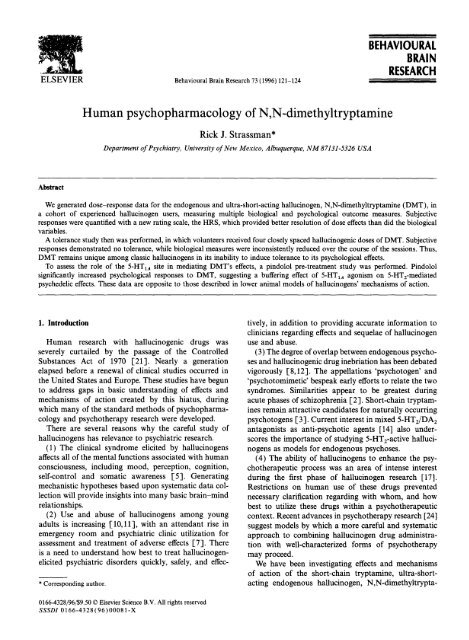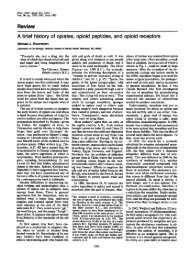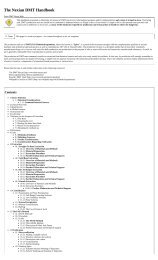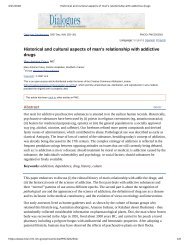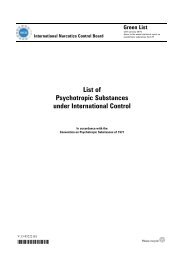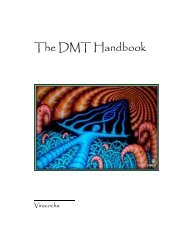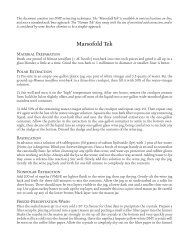dmt_psychopharmacology
Create successful ePaper yourself
Turn your PDF publications into a flip-book with our unique Google optimized e-Paper software.
ELSEVIER Behavioural Brain Research 73 (1996) 121-124<br />
BEHAVIOURAL<br />
BRAIN<br />
RESEARCH<br />
Human <strong>psychopharmacology</strong> of N,N-dimethyltryptamine<br />
Rick J. Strassman*<br />
Department of Psychiatry, University of New Mexico, Albuquerque, NM87131-5326 USA<br />
Abstract<br />
We generated dose-response data for the endogenous and ultra-short-acting hallucinogen, N,N-dimethyltryptamine (DMT), in<br />
a cohort of experienced hallucinogen users, measuring multiple biological and psychological outcome measures. Subjective<br />
responses were quantified with a new rating scale, the HRS, which provided better resolution of dose effects than did the biological<br />
variables.<br />
A tolerance study then was performed, in which volunteers received four closely spaced hallucinogenic doses of DMT. Subjective<br />
responses demonstrated no tolerance, while biological measures were inconsistently reduced over the course of the sessions. Thus,<br />
DMT remains unique among classic hallucinogens in its inability to induce tolerance to its psychological effects.<br />
To assess the role of the 5-HT,A site in mediating DMT's effects, a pindolol pre-treatment study was performed. Pindolol<br />
significantly increased psychological responses to DMT, suggesting a buffering effect of 5-HT1A agonism on 5-HT2-mediated<br />
psychedelic effects. These data are opposite to those described in lower animal models of hallucinogens' mechanisms of action.<br />
1. Introduction<br />
Human research with hallucinogenic drugs was<br />
severely curtailed by the passage of the Controlled<br />
Substances Act of 1970 [21]. Nearly a generation<br />
elapsed before a renewal of clinical studies occurred in<br />
the United States and Europe. These studies have begun<br />
to address gaps in basic understanding of effects and<br />
mechanisms of action created by this hiatus, during<br />
which many of the standard methods of <strong>psychopharmacology</strong><br />
and psychotherapy research were developed.<br />
There are several reasons why the careful study of<br />
hallucinogens has relevance to psychiatric research.<br />
(1) The clinical syndrome elicited by hallucinogens<br />
affects all of the mental functions associated with human<br />
consciousness, including mood, perception, cognition,<br />
self-control and somatic awareness [5]. Generating<br />
mechanistic hypotheses based upon systematic data collection<br />
will provide insights into many basic brain-mind<br />
relationships.<br />
(2) Use and abuse of hallucinogens among young<br />
adults is increasing [10,11], with an attendant rise in<br />
emergency room and psychiatric clinic utilization for<br />
assessment and treatment of adverse effects [7]. There<br />
is a need to understand how best to treat hallucinogenelicited<br />
psychiatric disorders quickly, safely, and effec-<br />
* Corresponding author.<br />
tively, in addition to providing accurate information to<br />
clinicians regarding effects and sequelae of hallucinogen<br />
use and abuse.<br />
(3) The degree of overlap between endogenous psychoses<br />
and hallucinogenic drug inebriation has been debated<br />
vigorously [8,12]. The appellations 'psychotogen' and<br />
'psychotomimetic' bespeak early efforts to relate the two<br />
syndromes. Similarities appear to be greatest during<br />
acute phases of schizophrenia [2]. Short-chain tryptamines<br />
remain attractive candidates for naturally occurring<br />
psychotogens [3]. Current interest in mixed 5-HT2/DA2<br />
antagonists as anti-psychotic agents [14] also underscores<br />
the importance of studying 5-HT2-active hallucinogens<br />
as models for endogenous psychoses.<br />
(4) The ability of hallucinogens to enhance the psychotherapeutic<br />
process was an area of intense interest<br />
during the first phase of hallucinogen research [17].<br />
Restrictions on human use of these drugs prevented<br />
necessary clarification regarding with whom, and how<br />
best to utilize these drugs within a psychotherapeutic<br />
context. Recent advances in psychotherapy research [24]<br />
suggest models by which a more careful and systematic<br />
approach to combining hallucinogen drug administration<br />
with well-characterized forms of psychotherapy<br />
may proceed.<br />
We have been investigating effects and mechanisms<br />
of action of the short-chain tryptamine, ultra-shortacting<br />
endogenous hallucinogen, N,N-dimethyltrypta-<br />
0166-4328/96/$9.50 © Elsevier Science B.V. All rights reserved<br />
SSSDI 0166-4328(96)00081-X
122 Rick J. Strassman/Behavioural Brain Research 73 (1996) 121 124<br />
mine (DMT), in a cohort of experienced hallucinogen<br />
users since November, 1990. Three reasons prompted<br />
choosing DMT as the compound with which to renew<br />
clinical research with hallucinogens. First, it is extremely<br />
short-acting [18], and adverse effects which might occur<br />
in a busy clinical research unit would be easier to<br />
manage. Second, it is a naturally occurring hallucinogen<br />
[ 1 ], whose role in normal and abnormal mental processes<br />
has yet to be explicated adequately. Third, its relative<br />
obscurity would not draw undue attention to our work<br />
in the early delicate stages of resuming this research,<br />
relative to the certain flurry of interest that a better<br />
known hallucinogen, such as LSD, might.<br />
We chose to study experienced hallucinogen users for<br />
the following reasons: experienced users would be less<br />
likely to panic during the powerful hallucinogenic effects<br />
expected from DMT; they would be able to provide<br />
more detailed accounts of DMT effects, particularly<br />
relative to other better known compounds, such as LSD<br />
and psilocybin, than naive subjects; finally, liability for<br />
development of subsequent 'drug abuse' would be less<br />
likely to be sustained in previous or current users.<br />
2. Summary of experiments and results<br />
Each of the three studies to be described utilized<br />
male and female experienced hallucinogen users who<br />
were otherwise medically and psychiatrically healthy.<br />
Screening was rigorous, and included a medical history,<br />
physical examination, electrocardiogram, urinalysis,<br />
complete blood count, 24-item chemistry panel, and<br />
thyroid functions. Subjects were excluded who were<br />
taking any medication regularly, or who had a history<br />
of high blood pressure. Psychiatric screening included a<br />
semi-structured psychiatric interview, the Structured<br />
Clinical Interview for DSM-III-R, Outpatient [20], and<br />
a survey of drug use history. Those with current drug<br />
abuse problems or history of psychosis were excluded.<br />
If volunteers had a history of a major depressive episode,<br />
they were included if the depression had resolved at<br />
least two years before beginning the study, and they<br />
were not in stressful life circumstances conducive to a<br />
relapse. In addition, if volunteers had not had what the<br />
research team considered 'full-blown' experiences on<br />
hallucinogenic drugs, they were not enrolled, as we<br />
wanted to ensure that volunteers could manage the<br />
highly intoxicated state of a high-dose DMT session.<br />
Studies all took place in the inpatient unit of the<br />
University of New Mexico Hospital Clinical Research<br />
Center. Prospective volunteers first received low<br />
(0.05 mg/kg} and high (0.4 mg/kg) screening doses of<br />
intravenous (i.v.) DMT fumarate, non-blind, to familiarize<br />
themselves with the research setting, provide an<br />
opportunity to drop out before extensive data were<br />
collected, and for idiosyncratic hypertensive responses<br />
to the low dose to be noted and exclude further<br />
participation.<br />
Our first dose-response study utilized 0.05, 0.1, 0.2<br />
and 0.4 mg/kg i.v. DMT fumarate, and saline placebo,<br />
in a double-blind, randomized design, using 12 volunteers.<br />
These results have been published [22,23]. A new<br />
rating scale for hallucinogen effects, the Hallucinogen<br />
Rating Scale (HRS), was developed, which clustered<br />
responses into six clinical categories: Affect, Volition,<br />
Somatic Effects ('Somaesthesia'), Perception, Cognition,<br />
and Intensity. Biological measures included: heart rate<br />
(HR), mean arterial blood pressure (MAP), pupil diameter,<br />
core temperature; and adrenocorticotropin (ACTH},<br />
/~-endorphin (/~E), prolactin (PRL), growth hormone<br />
(GH), melatonin, cortisol and DMT-free base blood<br />
levels. The 'psychedelic' threshold for DMT was at<br />
0.2 mg/kg, at which most biological effects also demonstrated<br />
statistically significant differences from saline<br />
placebo. Only melatonin showed no stimulation by<br />
DMT, while GH levels, although stimulated, could not<br />
be differentiated by dose. Pupil diameter, HR, MAP,<br />
ACTH,/~E, DMT, and subjective responses all peaked<br />
within 2 min; PRL and cortisol responses lagged by<br />
5 15 min, while temperature and growth hormone elevations<br />
did not begin until psychological effects had<br />
resolved, by 15-20 min.<br />
Psychological effects began nearly immediately during<br />
the DMT infusion, peaked within 2 min, and usually<br />
were completely resolved within 30 min. The higher<br />
doses of DMT produced a rapidly moving, multi-dimensional,<br />
kaleidoscopic display of intensely colored abstract<br />
and representational images. Auditory effects were less<br />
common, and were not frank hallucinations. Transient<br />
anxiety was common, but usually quickly became<br />
replaced by euphoria. Dissociation of awareness from<br />
the physical body was common, as were later feelings of<br />
alternating heat and cold. The higher dose effects completely<br />
replaced ongoing mental experience, and usually<br />
was described as more compelling and convincing than<br />
'ordinary' reality or dreams. Lower doses (0.1 and<br />
0.05 mg/kg) primarily affected physical and affective<br />
functions, with little perceptual disturbances. HRS data<br />
were more capable of distinguishing between dose levels<br />
(e.g., between 0.1 and 0.05 mg/kg) than were biological<br />
data. These data were interpreted in the light of<br />
5-HT mechanisms, especially 5-HT2 and 5-HT1A site<br />
activation.<br />
More experimental studies were then designed, the<br />
first being an assessment of DMT's ability to induce<br />
tolerance to its biological and psychological effects.<br />
Previous attempts in humans had failed to elicit tolerance<br />
[6], while heroic efforts in lower animals were<br />
required to do so [13].<br />
A fully hallucinogenic dose, 0.3 mg/kg, of i.v. DMT<br />
fumarate, or saline placebo, was administered at halfhour<br />
intervals, 4 times in a morning, to 13 experienced
Rick J. Strassman/BehaviouraI Brain Research 73 (1996) 121-124 123<br />
hallucinogen-using volunteers. Neither clinical interviews<br />
nor HRS results demonstrated development of<br />
psychological tolerance. HR decreased from the first to<br />
second session, and did not change thereafter, suggesting<br />
'reduction of anticipatory anxiety,' rather than 'tolerance;'<br />
while no reduction in MAP was seen. ACTH and<br />
PRL responses did decrease over the course of the<br />
morning, suggesting tolerance development. This<br />
differential tolerance development was interpreted as<br />
being mediated by independently regulated desensitization<br />
of relevant 5-HT receptor mechanisms. Thus, DMT<br />
remains unique in its inability to develop tolerance to<br />
its psychological effects.<br />
Our last study completed assessed the role of the<br />
5-HT~A site in mediating DMT effects. This was performed<br />
because DMT has nearly equal affinity for the<br />
5-HT~A and 5-HT2 sites [4], and the behavioral effects<br />
of the hallucinogen 5-methoxy-DMT are blocked by<br />
pindolol [ 19], a potent 5-HT~a antagonist [ 16 ].<br />
Twelve volunteers received a sub-hallucinogenic dose,<br />
0.1 mg/kg, i.v. DMT, or saline placebo, in combination<br />
with 30 mg oral racemic pindolol, or placebo-pindolol,<br />
in a four-cell double-blind, randomized design.<br />
Volunteers found that pindolol pre-treatment enhanced<br />
DMT effects by two to three times, which was substantiated<br />
by scores on the HRS, in which four to six clinical<br />
clusters demonstrated a significant enhancement by pindolol.<br />
PRL responses were reduced, while those of<br />
ACTH were unaffected. HR responses were blunted,<br />
probably due to pindolol's anti-sympathetic effects,<br />
while MAP effects were enhanced. These behavioral<br />
data, opposite to those noted in the animal literature,<br />
suggest an inhibitory effect of 5-HT~A agonism in tryptamine-induced<br />
hallucinogenesis. Pindolol blockade<br />
allowed unopposed 5-HT2 agonism, which we believe<br />
also mediated the enhanced MAP responses to DMT.<br />
The reduced PRL response supports a stimulatory role<br />
for the 5-HTIA site in human PRL secretion, while the<br />
lack of effect on ACTH suggests a minimal role for this<br />
site in the DMT response. These data also are important<br />
because they demonstrate differential (and at times,<br />
opposite) regulation of neuroendocrine, cardiovascular,<br />
and subjective effects of hallucinogens in humans.<br />
3. Conclusions and future directions<br />
DMT can be safely administered to experienced hallucinogen<br />
users in fully 'psychedelic' doses. By so doing,<br />
earlier clinical research findings can be extended to<br />
include contemporary psychopharmacological methodologies,<br />
and basic hypotheses tested. In the case of DMT,<br />
a battery of neuroendocrine data have been generated,<br />
and a new rating scale developed. The lack of tolerance<br />
to DMT's psychological effects has been established<br />
more rigorously, which strengthens its role as a putative<br />
endogenous 'psychotogen' 1-9]. Our study of the role of<br />
the 5-HTIA site in mediating DMT effects in humans<br />
has yielded results opposite to those expected from<br />
animal data.<br />
Current studies include a pre-treatment protocol using<br />
the only currently available 5-HT2 antagonist, cyproheptadine,<br />
which will expand previous human work with<br />
this combination [15]. In addition, we are beginning to<br />
develop comprehensive dose-response data for the<br />
longer-acting, and more widely abused hallucinogen,<br />
psilocybin (4-phosphoryloxy-N,N-DMT).<br />
Acknowledgment<br />
This investigation was supported by the Scottish Rite<br />
Foundation for Schizophrenia Research, NMJ; National<br />
Institute on Drug Abuse grants RO3-DA06524 and<br />
RO1-DA08096; University of New Mexico General<br />
Clinical Research Center grant RR00997; the Scott<br />
Rogers Fund of the University of New Mexico; and<br />
University of New Mexico Department of Psychiatry<br />
research funds. The authors would like to thank David<br />
E. Nichols, Ph.D., Purdue University, for synthesis of<br />
the DMT fumarate used in this study.<br />
References<br />
[ 1 ] Axelrod, J., The enzymatic N-methylation of serotonin and other<br />
amines, J. Pharmacol. Exp. Ther., 138 (1962) 28-33.<br />
12] Bowers, M., Jr. and Freedman, D.X., 'Psychedelic' experiences in<br />
acute psychoses, Arch. Gen. Psychiatry, 15 (1966) 240-248.<br />
1"3] Corbett, L., Christian, S.T., Morin, R.D., Benington, F. and Smythies,<br />
J.R., Hallucinogenic N-methylated indolealkylamines in the<br />
cerebrospinal fluid of psychiatric and control populations, Br.<br />
J. Psychiatry, 132 (1978) 139-144.<br />
[4] Deliganis, A.V., Pierce, P.A. and Peroutka, S.J., Differential interactions<br />
of dimethyltryptamine (DMT) with 5-HTla and 5-HT 2<br />
receptors, Biochem. Pharmacol., 41 (1991) 1739-1744.<br />
[5] Freedman, D.X., On the use and abuse of LSD, Arch. Gen. Psychiatry,<br />
18 (1968) 330-347.<br />
[6] Gillin, J.C., Kaplan, J., Stillman, R. and Wyatt, R,J., The<br />
psychedelic model of schizophrenia: The case of N,N-dimethyltryptamine,<br />
Am. J. Psychiatry, 133 (1976) 203-208.<br />
[7] Gold, M.S., Schuchard, K. and Gleaton, T., LSD use among US<br />
high school students (letter), JAMA, 271 (1994) 426-427.<br />
[8] Hollister, L., Drug-induced psychoses and schizophrenic reactions:<br />
A critical comparison, Ann. N.Y. Acad. Sci., 96 (1962)<br />
80-92.<br />
[9] Hollister, L.E., Some general thoughts about endogenous psychotogens.<br />
In E. Usdin, D.A. Hamburg and J.D. Barchas (Eds.),<br />
Neuroregulators and Psychiatric Disorders, Oxford University<br />
Press, New York, 1977, pp. 550-556.<br />
[10] Johnston, L.D., O'Malley, P.M. and Bachman, J.G., National<br />
Survey Results on Drug Use from Monitoring the Future Study,<br />
1975-1992, Vol. II. College Students and Young Adults, National<br />
Institute on Drug Abuse, Rockville, MD, 1993.<br />
[11] Johnston, L.D., O'Malley, P.M. and Bachman, J.G., National<br />
Survey Results on Drugs Use from Monitoring the Future Study,
124 Rick J. Strassman/Behavioural Brain Research 73 (1996) 121-124<br />
1975-1992, Vol. I. Secondary School Students, National Institute<br />
on Drug Abuse, Rockville, MD, 1993, 269 pp.<br />
[12] Kleinman, J.E., Gillin, J.C. and Wyatt, R.J., A comparison of the<br />
phenomenology of hallucinogens and schizophrenia from some<br />
biographical accounts, Schizophr. Bull., 3 (1977) 560 586.<br />
[13] Kovacic, B. and Domino, E.F., Tolerance and limited crosstolerance<br />
to the effects of N,N-dimethyltryptamine (DMT) and<br />
lysergic acid diethylamide-25 (LSD) on food-rewarded bar<br />
pressing in the rat, J. Pharmacol. Exp. Ther., 197 (1976) 495 502.<br />
[14] Meltzer, H.Y., Clinical studies on the mechanism of action of<br />
clozapine: the dopamine-serotonin hypothesis of schizophrenia,<br />
Psychopharmacology, 99 (1989) S18-$27.<br />
[15] Meltzer, H.Y., Wiita, B., Tricou, B.J., Simonovic, M., Fang, V.S.<br />
and Manov, G., Effects of serotonin precursors and serotonin<br />
agonists on plasma hormone levels. In B.T. Ho, J.C. Schoolar<br />
and E. Usdin (Eds.), Serotonin in Biological Psychiatry, Raven,<br />
New York, 1982, pp. 117-139.<br />
[16] Oksenberg, D. and Peroutka, S.J., Antagonism of<br />
5-hydroxytryptaminelA (5-HT1A) receptor-mediated modulation<br />
of adenylate cyclase activity by pindolol and propranolol isomers,<br />
Biochem. Pharmacol., 37 (1988) 3429 3433.<br />
[17] Pahnke, W.N., Kurland, A,A., Unger, S., Savage, C. and Grof.<br />
S., The experimental use of psychedelic (LSD) psychotherapy,<br />
JAMA, 212 (1970) 1856 1863.<br />
[ 18] Sai-Halasz, A., Brunecker, G. and Szara, S.I., Dimethyltryptamin:<br />
ein neues Psychoticum, Psychiat. Neurol., Basel, 135 (1958)<br />
285-301.<br />
[19] Spencer, D., Jr., Glaser, T. and Traber, J., Serotonin receptor<br />
subtype mediation of the interoceptive discriminative stimuli<br />
induced by 5-methoxy-N,N-dimethyltryptamine, Psychopharmacology,<br />
93 (1987) 158-166.<br />
[20] Spitzer, R., Williams, J. and Gibbon, M., Structured clinical interview<br />
for DSM-llI-R--Outpatient version, Biometric Research<br />
Department, New York State Psychiatric Institute, New York,<br />
1987.<br />
[21] Strassman, R.J., Human hallucinogenic drug research in the<br />
United States: a present-day case history and review of the process,<br />
J. Psychoactive Drug, 23 (1991) 29-38.<br />
[22] Strassman, R.J. and Quails, C.R., Dose-response study of N,Ndimethyltryptamine<br />
in humans, 1. Neuroendocrine, autonomic,<br />
and cardiovascular effects, Arch. Gen. Psychiatry, 51 (1994)<br />
85-97,<br />
[23] Strassman, R.J., Qualls, C.R., Uhlenhuth, E.H. and Kellner, R.,<br />
Dose-response study of N,N-dimethyltryptamine in humans, I1.<br />
Subjective effects and preliminary results of a new rating scale,<br />
Arch. Gen. Psychiatry, 5l (1994) 98-108.<br />
[24] Weissman, M.M. and Markowitz, J.C., Interpersonal psychotherapy,<br />
Arch. Gen. Psychiatry, 51 (1994) 599 606.


